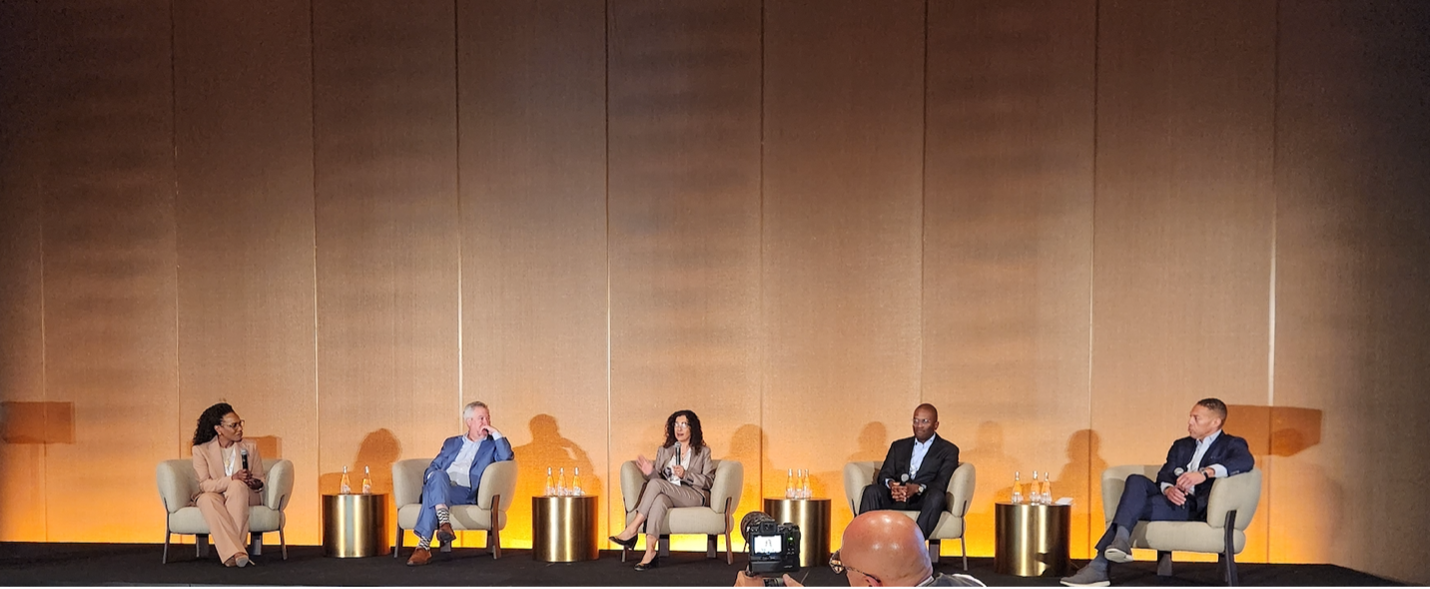Despite relentless interest rate hikes, contraction in multifamily rental rates in the face of record deliveries, and almost universal disdain for all things office, lenders, fund managers, and operators alike have tried to maintain an upbeat view on the state of the market in ‘Q1 2023. Now, in the face of more headwinds in ‘Q2, those convictions are being tested. A distinguished panel of real estate experts shared their outlook at the REEC 2023 Spring Conference.
Top of mind was the recent failures of Signature and Silicon Valley Bank, and whether weakness in the banking sector would further constrict the availability of real estate debt. Panel moderator Lynn King-Tolliver, CEO of Archere Investment Management, interviewed Richard Green, economist and professor at University of Southern California, who provided a sobering take.
“I’m very sensitive to the issue of interest rates and when I started seeing what the Fed was doing over the past year and started looking at bank balance sheets, I started to get very worried. Banks were (during the pandemic) investing in long term treasuries, securities, and mortgage-backed securities, certain things with long duration. The problem with long duration is that if you have a bond that is paying 2% and now it’s a 4% environment, the value of that bond drops…a lot.”
Green went on explain that as a result of these mark-to-market adjustments, the value of securities had fallen so precipitously that if a bank was forced to sell them quickly, in response to mass depositor redemption requests, for instance, they could become insolvent. He pushed back on the notion that the Fed’s quick response to recent bank failures had truly stabilized markets, since sustained rate hikes will only exacerbate the issue.
“Either it will kill a bank quickly if depositors want their money back and yes there’s now a liquidity facility where the Fed will lend money for deposits, but they are lending at the Fed Funds Rate, so you own a long-term treasury with 2% interest you are borrowing from the fed at 5%, you are losing money on that transaction. So that’s the alternative. You are bleeding out slowly as opposed to being done today. Until the fed starts bringing rates down again, you won’t see this problem go away.”
Green’s somewhat dire take may seem over-stated, until he further peeled back the layers of the onion, explaining that even in instances where banks showed prudent risk management by hedging their interest rate risk, the nature of such hedges also created other vulnerabilities. “A number of banks are using derivatives to hedge their interest rate positions. The problem is that when you are hedging you are hedging with a counterparty. So, this is what we don’t know. If banks are hedging their interest rate risk, can the counterparty actually meet their contractual obligation if they have to be implemented? And the problem with interest rate swaps is that they are over the counter transactions. They are not exchange traded. So, you know don’t know if the capital is there to fulfil the contract if needed.”
Green wasn’t all doom and gloom. He predicted that the combination of bank strain and reduced inflation would force the Fed to retrench and pause further rate hikes by fall of 2023. “When we look at apartment rents across the country, they are down 6% from a year ago. And the thing is the cost of living in a unit is about 40% of CPI. The problem is that it doesn’t show up for a while because only a twelfth of leases turn over each month and so this decline in rents is a recent phenomenon. I think end somewhere between 2-3% (inflation) by the fall. And at that point I think the Fed will have to give up. Because we will see more bank failures and that will put pressure on the Fed to reverse.”
Later in the conversation, Newmark’s Anita Paryani-Rice added real-time market color to support a bank pullback from CRE lending. “Where we see most of the struggle is on the bank side where the banks have loans at 3% interest rate, they want to just get paid off but not place new capital.” She also pointed that while several other alternative sources exist, the higher cost of capital makes it very difficult to transact. “As far as other debt sources, you have CMBS. They are willing to place capital at 6.5%-7.0%, just not too many takers at the moment. And debt funds, plenty of money for value-add transactions but this time last year SOFR was about 50bp, now we are approaching 5%, so you add any spread to that what deals are penciling going from 8% maybe trending to 8.5% before we trend down? So, there is capital, but it is more expensive and until sellers and buyers come to terms with the value of real estate, we will see capital on the sidelines.” One bright spot in the market? Agency lenders on multifamily properties. Paryani-Rice elaborated. On the agency side, Freddie and Fannie have plenty of money to put out there, particularly mission driven product with naturally occurring affordable housing. They really want to place a lot of money in the smaller deals…50 units and under and those cases, underwrite to 35-year amortization.”
The discussion later shifted to the equity landscape. Starwood Capital’s Khalif Edwards shared spoke to the challenging institutional fundraising environment. “It’s counterintuitive. Investor sentiment is actually fairly strong and a lot of the conversations I am having with institutional investors, they kind of understand that with all the dislocation in the market it will probably be a good time to invest, but the issue is allocations (to real estate) are way down so it’s a very challenging capital raising environment. It has to do with the denominator effect. The denominator (total asset values) has come down because volatility in the stock market and real estate valuations have not come down as quickly, so they just don’t have capital to invest (into the sector – due to over-allocation). As that goes away, that will hopefully free up more capital for third and fourth quarters.”
He went on to explain why multi-strategy investment managers have an edge in the current environment. “There is a lot of interest in diversified strategies, strategies that have some sort of distress because institutional investors are looking for managers that can take advantage of the entire global landscape across all regions and product types.” He also pointed out that while there is interest in multifamily and industrial equity, investors saw compelling opportunities to allocate capital to debt as banks and insurance companies were pulling back.
Arc Capital’s Neville Rhone, Jr. shared a similar sentiment, arguing it was difficult to make deals work today acting under the classic operator model. “How we approach the world now there is a gap between a new loan versus what it used to be, so we can sometimes we can be helpful in recapitalizations, sometimes we see loan sales, we’re seeing that more, so the way you actually get into transactions has changed. Far different than buying at what we think is a good price and believing in growth and UW a lower cap rate down the road, more structuring, more problem solving a lot more negotiation, much more thinking about the capital stack and solving it.”
Ms. King-Tolliver, an advisor to real estate developers, also explained that short-term challenges in the capital markets had its benefits. “If you are a developer it’s a great time to be getting the work done and teeing up your developments because when the debt markets turn, and there has been a huge slowdown on pipeline for multi and single family but the demand and need for housing has not gone anywhere.”
Unsurprisingly, on the topic of office none of the investment managers on the panel were bullish. Nonetheless, Green attempted to level-set both the importance of office to the CRE sector and the uncompromising negativity that shrouds it. “I know it seems big because they (the buildings) are so tall, but it’s actually a fairly small share, completely dwarfed by the residential sector, specifically apartments. I would suggest maybe office is not quite as bad as people think. It’s bad. But remember the 1989-1991 office market. What were vacancy rates in Chicago? 30, 40, 50 percent. One of the things that happens when things get cheap enough people start consuming it. I’m seeing offices being acquired for less than $200 PSF, but if you can get a 10% cap rate at cheap rent and think more creatively how tenants you will take maybe there will be some comeback.”
Despite the market challenges discussed, there was still sense that the disruption will create plenty of compelling opportunities. Rhone Jr. observed “the reality is that valuations have not come through the system. I’m not sure if anyone in the room is invested in this property (Fairmont Century Plaza) but this property was re-developed for about $2.5 billion. It sold in foreclosure for $1 billion. So that’s like 40 cents on the dollar. And it’s a nice property!! There is still that winding through the system. It is a bit of a slow train wreck working its way through. As a whole, however, our view is that it is a moment in time and there is a lot of dry powder out there sitting and waiting to pounce. So, when pricing shifts happen, someone shows up.”
Written by Vernon Beckford at [email protected]



